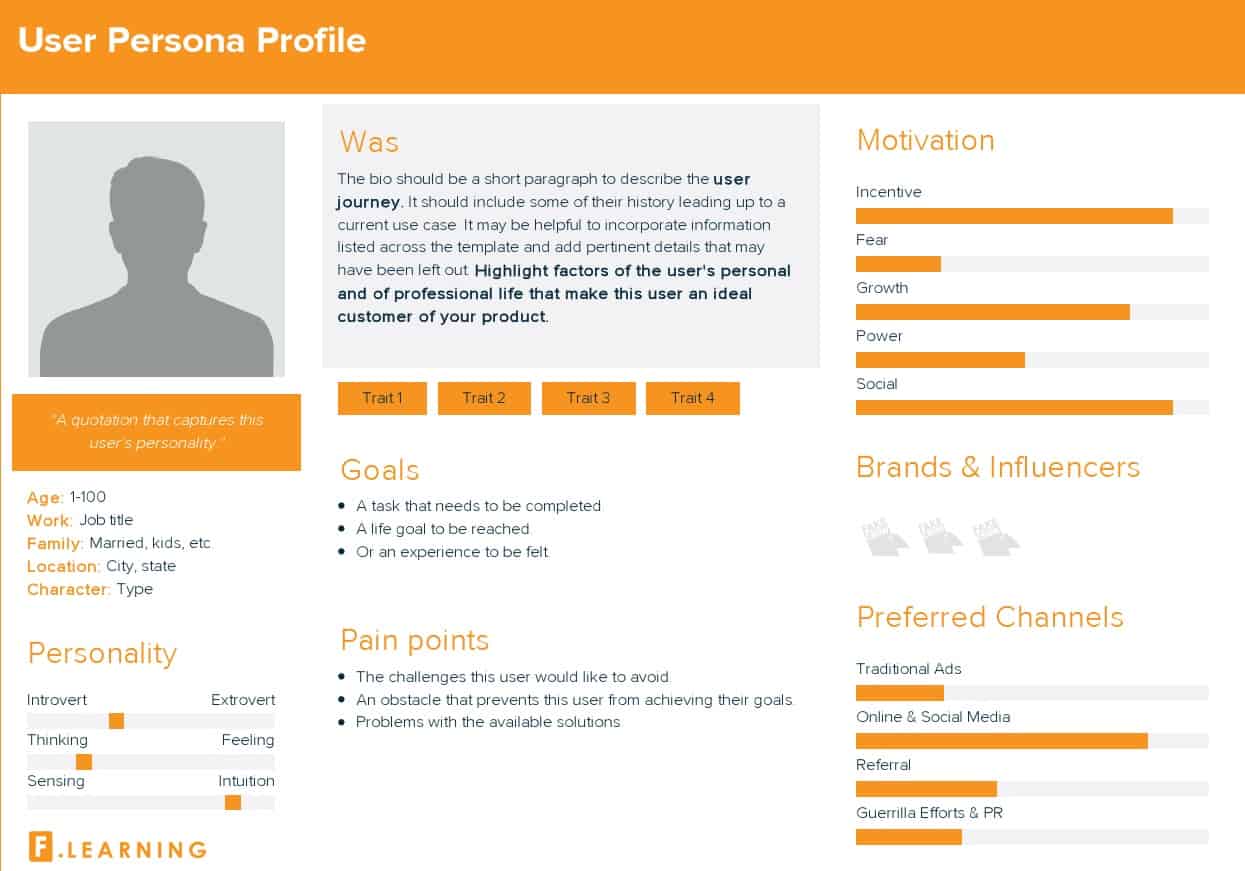It is not easy to sell online training courses. E-learning industry is growing exponentially and competitions come with the growth. Define your uniqueness of your online training courses following these 03 essential tips.
Before Promoting Online Training Courses,
Know Your Customer!
The first vital step to promote your online training courses is to identify your target audience. It would be a huge waste of time and money if you pour your heart and soul into promoting your online training courses to Mr. No One! (You are not Arya Stark). Lucky for you, there are many actionable approaches you can adopt to ease the pain of aimlessly promoting your e-learning courses.
One of the most effective strategies to have a deeper understanding of your audience is Customer Persona.
How online course can benefit from Customer Persona
Customer Personas are fictional, generalized representations of your ideal customers. By internalizing the ideal customers you are trying to attract and relate to your buyer as real humans, you can gain a broader comprehension of your audiences’ pains, motivations, and objectives. Now after you have become your audiences’ best friend, your craftsmanship in content curation is immensely stronger; you can tailor your online training courses content to the specific needs of different groups and achieve higher customer acquisition.
Eventually, Customer Persona will greatly improve customer loyalty. As Customer Persona makes your online training courses more realistic, more relatable by personifying audience groups. When the audience feel that they have personalized care, they will come back to you, speak good of your training courses and help you to expand your market.
03 simple steps to build your Customer Persona
Step 1: Group your audience
Your audiences are your customers. Like any other business, you will have a wide variety of customers. Do people come to your online training course with a view to broadening their knowledge or simply for career advancement? Are they willing to pay the premium price to get the most out of your online training courses or simply register for the trial version? Are they corporate clients whose decision to buy your online training courses depends on the collective business goals and needs of their employees? Knowing your customer makes a huge difference.
Therefore, it is the best to separate them into categories based on your marketing initiatives before building your Customer Persona. The advisable and cost-effective approach would be choosing the audience group who can potentially generate the most revenue for you.
Step 2: Research your audience
Now that you have a general idea about your target audience group, it is high time to drill deeper. You want to know about your customer background, their goals, their challenges, how they make buying decisions, and what (or who) influences them.
You can gather the customer information through surveys, interviews, and blog comments and feedback. Several online tools designed for established online business can quickly help you have a better picture of who your current customers are. Some of these tools include Facebook Insights, if you have a Facebook Page set up for your business, as well as Google Analytics Audience Reports, which has some detailed information on demographics and some psychographics of your website visitors.
Step 3: Create your Customer Persona
With all the data you can assemble, creating Customer Persona will be a fun ride. Remember to compile all information in an organized, concise, yet appealing format that can enable your team to quickly grab key insights when questions about a specific audience group arise.
Next, outline facts about your customer, including the age, gender, and job role. Quick bullet points work well here. A Customer Persona should look like the example below.
Promoting your online training course
Content is the king, always!
With Customer Persona, now you have a detailed picture of your customer. It is time integrate Customer Persona into your online training course strategy and make your Value Proposition stand out from your competitors. Here are some essential tips:
Adopt A Creative Approach For Content Curation
To engage your audience, your e-learning course must cater to their needs. Make sure your training products work by constantly testing and refining your online courses. One of the best approaches is Human-Centered Design. Human-centered design is a creative approach that starts with the people you’re designing for and ends with new solutions that are tailor-made to suit their needs.
Human-Centered Design consists of five main phases.
- Emphasize: Similar to the process of building Customer Persona, in this phase, you have to immerse yourself in the lives of your audience and come to deeply understand their needs.
- Define (the problem): After you have an extensive compilation of all information you have gathered during the Empathise stage. You will have a closer look at your observations and synthesize them in order to define the core problems that your audiences are facing. To illustrate, instead of defining the problem as your own wish such as, “We must increase our sales of training course on Emotional Intelligence by 15%,” a much better way to define the problem would be, “Modern day workers need to be emotionally healthy and better self-management skill to effectively collaborate with others in corporate culture ”
- Ideation: In this phase, you need to apply what you learn in Customer Persona identifying opportunities for design and bring out every possible solution that can improve your audience’s learning experience and help them meet their goals.
- Prototype: This is an experimental phase, and in this stage, the solutions are implemented within the prototypes and, one-by-one, they are investigated and either accepted, improved and re-examined or rejected on the basis of the users’ experiences.
- Test: You’ll bring your solution to life and put it to a rigorous test. The result generated in this phase will redefine the prototype. Alterations and Refinement will be made in order to derive as deep an understanding of the product and its users as possible.
With a detailed and insightful content plan for your online training course, you will have a dazzling value proposition aligns with the needs of your target audience and reflects the uniqueness of your online training courses over countless competitors.
Make your online training courses look stunning
03 interesting facts about the relationships between your brain and visuals:
- Visuals are absorbed and processed 60,000x faster compared to text
- 40% of human nerve fibers are connected to the retina
- Human eyes can register 36.000 visual messages every hour
It is as clear as day that human is instinctively wired to visual learning and prone to processing visual data much better. A five-minute e-learning video with animation and data visualization can easily over-power a fifteen-minute talking-head e-learning video covering the same subject. Visual language is known to have stretch human cognitive capabilities and help learners to quickly have a firm grab at subjects.
Visuals are no longer a supporting tool for online training courses, the race for uniqueness in online training courses demands visuals be integrated and in perfect coordination with training content. Therefore, design your online training course look as effective as possible!
Visual solutions help you maximize your online training courses’ effectiveness. You would benefit from animation and visual design, including but not limited to animated learning video, infographics for educational purposes, instructional graphic design, static illustration, etc.
Social Media is your best friends
It is a hard-knock world we live in. You produce quality online training courses but still, there is a high chance that your products get ignored.
Getting some sales and Selling more training courses require a proper marketing strategy. If you don’t know where to start, don’t worry, we have your back. Here are 06 simple ways you can utilize social media tools to promote your online training courses
1. Create a Facebook page and Run Facebook ads
A combination between Facebook Ads and your Customer Persona can help you quickly reach your target audience and draw them to your training courses.
2. Start a Facebook group
Create a Facebook Group focus on your topic is a smart tactic to build a robust community of people who are the potential audience for your online training courses. Your Managing a Facebook Group by regularly posting relevant content is also great for branding as it can position you as an authority on your topic. Facebook Community can also provide a great outlet for your previous customers and fans of your online courses to air the approval and appreciation via social proof and data-based testimonials.
3. Start a Linkedin group
Similar to Facebook, a Linkedin Group is a great platform for community building. Linkedin can be specifically useful if your target markets are professionals. As Linkedin is created for professional networking, a Linkedin group can open the door for you to various partnership opportunities, client referrals, etc.
4. Share Infographics on Pinterest
Everyone loves infographics and they are the star on Pinterest. Design simple infographics that share some interesting facts, statistics, or a step-by-step process related to your topic and publish it on Pinterest. Remember to include a link to drive traffic from Pinterest to your online training courses.
5. Answers question on Quora
Search for discussions related to your online course topic on Quora. Add value to the discussion by sharing your insights. Don’t try to hard sell your course in your posts, but definitely include a link to your website or course in your Quora bio.
6. Share bite-sized videos on Instagram and Facebook
The citizens of this fast-paced world expect engaging learning experiences and quickly favor another competitor’s offerings if you are slow to meet their needs. The keyword here is “quickly engaging”. Bite-sized videos come in handy in this situation.
Bite-sized learning enables learners to quickly and conveniently absorb content, especially on mobile devices. Sharing bite-sized videos on Instagram and Facebook will directly address the two essential need of modern-day consumers: Constantly checking social media and having learning opportunities during gaps in busy work schedules.
Now it’s high time to march forward and start to design the best online training courses. If you have other tactics you’re going to use that aren’t listed here, share them below. We are listening!
Read further:

Sean Bui, the founder and creative director of F.Learning Studio, is a respected leader in the e-learning and multimedia production industry. With over 10 years of experience, he has dedicated his career to helping organizations create engaging and impactful learning experiences.
Under his leadership, F.Learning Studio has grown into a trusted partner for organizations in the education, healthcare, and corporate training sectors, producing over 2,000 minutes of educational animation.



![Best 10 Educational Animation Software [Update 2025] 3 Analyzing the needs and the goal of the project is important](https://flearningstudio.com/wp-content/uploads/2021/06/Top-anim-tools-01-420x370.png)

